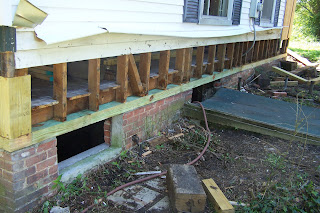If you are not a contractor, then you may not know what a sill plate is. I sure didn't until I had a need to know. Unfortunately, I now have a need to know. As we said in a previous post, the sill plates in Glenlochan were rotted and termite-damaged - sounds problematic, doesn't it? But, just how serious of an issue is a rotted, damaged sill plate? Well, Wikipedia defines a sill plate as follows: A sill plate or sole plate in construction and architecture is the bottom, horizontal member of a wall or building to which vertical members are attached. Sill plates are usually composed of lumber.
If case you are a visual learner, here's two pictures of one of the sill plates of the house (rotted, damaged and all). The entire weight of the home is resting on the sill plates - both stories of the home, the attic, and the heavy old slate roof, and everything else in between. Sill plates are apparently pretty important to the structural integrity of the house.
There are 4 sill plates running under the entire perimeter of the house - front, back and 2 sides, and out of the 4 sill plates under the home, 3 had to be replaced. For a job that involves jacking up a house, pulling out long beams, re-mortering the bed, and replacing the rotted beams with brand, spanking-new, sill plates, reinforcements were required - yup, Joe came out to give his old man a hand with this job.
Considering all of the things that could go wrong when 2 men are jacking up a 2-story plus home by themselves, the sill plate replacement progressed remarkably smoothly. Here's a few pictures documenting the progress:
We are happy to report that Glenlochan is resting comfortably on 3 new sill plates (and one original sill plate) and is ready for the next stage.
Glenlochan -The Beginning

Glenlochan - The Beginning
Glenlochan Today

Glenlochan Today
Sunday, May 20, 2012
Saturday, May 12, 2012
Oyster Update
Our oysters outgrew their original home so we had to invest in a spiffy new "Taylor Float" for half of them to move into.
By moving half of them to a new home, all of the oysters will have more room to grow and easier access to the water they are constantly filtering. The new Taylor float is in the rear; the original bag float in front:
We may have waited a bit too long to split them - some of the oysters were much bigger than other ones in the bunch. As such, we had to sort them by size. The bigger ones were moved to the Taylor Float, but the smaller ones went back into the bag float. The "holes" in the Taylor Float are much bigger so the smaller oysters actually fell right through them.
Here's was our starting point last summer and where we are now:
By moving half of them to a new home, all of the oysters will have more room to grow and easier access to the water they are constantly filtering. The new Taylor float is in the rear; the original bag float in front:
We may have waited a bit too long to split them - some of the oysters were much bigger than other ones in the bunch. As such, we had to sort them by size. The bigger ones were moved to the Taylor Float, but the smaller ones went back into the bag float. The "holes" in the Taylor Float are much bigger so the smaller oysters actually fell right through them.
Here's was our starting point last summer and where we are now:
The floats were put back in the water and secured to the pier - and the oysters are busy growing for eventual placement on a protected reef in the Bay.
Subscribe to:
Posts (Atom)
















